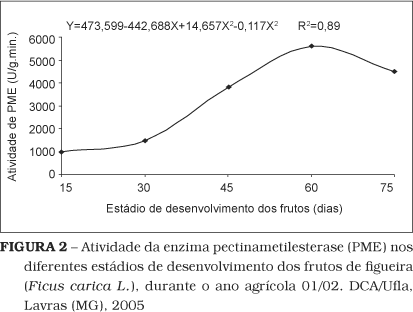With the objective of evaluating the physical, physical-chemical, enzymic and cell wall characterization during the different developmental stages of the fig tree fruits under irrigation in Northern Minas Gerais, the present work was developed during the 2001/2002 cropping cycle in the Unidade de Produção Frutícola da Escola Agrotécnica Federal de Salinas (Fruit Growing Unit of the Federal Agrotechnical School of Salinas (Eafsal), town of Salinas. Plants of two years and a half after transplanting and with twelve well developed primary branches (pernadas = the first strong branches of a tree) and 2.5x1.5 m spacing were utilized in this experiment. The design applied was completely randomized with two replicates and a total of 40 marked plants. The data collected were concerning 2001/2002 cropping cycle for the June-pruned plants. Evaluated during the different developmental stages of fig tree fruits activity of the enzimes, chemical composition, physical evaluate, neutral sugars and cell wall components. As polyphenoloxidase and peroxidase activity was decreasing, polygalacturonase activity increased throughout the development of the fruits. The fruits reached harvest point for industry and in natura consumption at 30 and 75 days from the differentiation of the buds in syconium, respectively. A significant increase took place in the contents of total soluble solids, total soluble and reducing sugars during the development of the fruit. Both pH and TTA ranged very little during fruit development. The average diameter of the fruits was always inferior to the average length, reaching 51.99 mm and 59.18 mm, respectively at 75 days. The average weight of 53.23 g was reached at 75 days. Predominating neutral sugars were galactose, arabinose and xylose whereas fucose, mannose and glucose and rhamnose were those present in smaller amount in the cell wall during the different developmental stages of the fruits. With the maturation of the fruits, there was a reduction of the chief components of pectic polysaccharides (galactose, arabinose and rhamnose), whilst the components of the hemicellulose fraction (xylose, glucose and mannose) tended to increase. Cellulose solubilization and fall in the contents of hemicellulose took place from 60 days when the fruit already in the physiological maturity, starts softening process, as related with pectin solubilization by the higher activity of the pectinnemethylesterase and polygalacturonase enzymes.
Ficus carica L.; characterization; development; fruit











